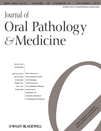Cell apoptosis and proliferation in salivary glands of Sjögren’s syndrome
Abstract
J Oral Pathol Med (2011) 40: 721–725
Background: Sjögren’s syndrome (SS) occurs associated with parotid neoplasm, non-Hodgkin’s B-cell lymphoma, which could impair the condition or be life-threatening for patients. The aim of this work was to analyze cell proliferation and apoptosis modifications in acinar, ductal and inflammatory infiltrate in salivary glands (SG) in patients with Sjögren Syndrome, keratoconjunctivitis, or stomatitis sicca or in healthy subjects, to establish parameters that indicate the likelihood of malignancy of the disease in populations at risk.
Methods: A study was performed with n = 58 histological samples of lower lip SG from patients diagnosed with SS, keratoconjunctivitis, or stomatitis sicca (SICCA) and from healthy subjects (C). Ki67 and caspase-3 immunolabeling were performed.
Results: The most important result was significant differences between the three study groups in Ki67 and caspase-3 markers (P < 0.0001) in infiltrated lymphocytes.
Conclusion: The results of this work are indicative of a high degree of proliferation (85%) in infiltrated lymphocytes (IL) associated with SS which, according the literature, could be considered a risk. Furthermore, the markers used in this work are widely known and represent a lower cost than others and can be used to determine risk groups within the population of SS patients, enabling their follow-up.




